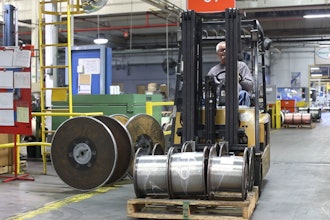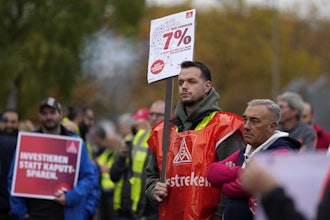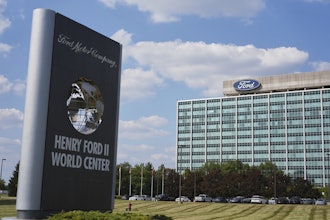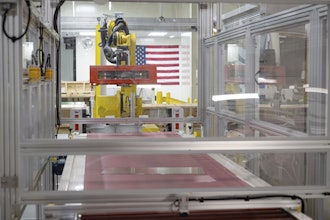- 1 -
SAP Digital Economy in the Wholesale Distribution Industry Whitepaper (01/16) © 2016 SAP SE. All rights reserved
Embracing the
Digital
Economy in the
Wholesale
Distribution
Industry
Survive and
Thrive
Secure Your Leadership
Position in the Value
Chain
- 2 -
SAP Digital Economy in the Wholesale Distribution Industry Whitepaper (01/16) © 2016 SAP SE. All rights reserved
Dear Customers,
Innovator or follower? Disruptor or disrupted? Growing or stagnant? Digital predator or digital
prey? The choice is yours.
Today’s competitive markets demand that wholesale distributors evolve faster, become more
efficient, and provide memorable customer experiences. For decades, distributors have thrived
primarily on great, existing customer relationships. In the new millennium, simply breaking bulk
and having great relationships are not enough. Today, leading distributors are using digital
technology to create, deliver, and sustain new and meaningful customer experiences. If you’re
not thinking about how to incorporate technologies like drones, 3D printing, smart vending
machines, customer-facing apps, and more into your strategy, you will be left behind.
To survive, companies must rethink business processes and models and use of their vast wealth
of data to remain relevant and leapfrog their competitors. Disruptors are making headway in
markets traditionally served by distributors, and customer and employee expectations are
changing rapidly.
Big change always comes with risk, but also offers untold opportunity for innovators.
Leading distributors are:
• Reimagining business models to find new revenue and profit sources. Can you become a
distributor primarily focused on value-added services, or a real-time distributor, or perhaps an
infinite inventory distributor?
• Reimagining business processes by using digital technology to optimize business outcomes
by implementing bold initiatives to completely automate core, highly administrative processes.
Are large, highly manual departments like accounts payable destined to become extinct? Can
business networks be utilized to automate the processes to become completely touch-less?
• Reimagining the role and structure of their workforce to support their current and future
business. This can, and may, include the elimination of certain departments and up-skilling
those employees to be customer-focused and revenue-generating. Can current accounts
receivable departments be transformed into organizations that are highly customer-centric
with personal-banking-like services?
Reimagining business requires guts, determination, and a digital framework that underlies both
internal business processes and models as well as external customer interactions. All
stakeholders – customers, suppliers, and employees – will use digital innovation. This paper will
show you how you can begin to execute on this vision by providing examples of how you can
survive in the present and thrive in the future. This will require a focus on customer engagement
opportunities, new services, integrated cloud-based business networks, tapping into an extended
workforce, and building the bridge to advanced solution landscapes using new technologies.
This document offers our perspective on where the industry will go and how SAP can help in the
evolution of the digital economy. We thank you for your interest and look forward to your
feedback.
Karen S. Lynch
We envision the digital
framework for wholesale
distribution as one that will
enable you to win through
innovative new business
models, that will simplify
and improve the way you
work with your customers
and suppliers, and enable
your employees to grow
their businesses.
Karen S. Lynch
Vice President, Global Head,
Wholesale Distribution Industry
Business Unit
SAP
KAREN’S POINT OF VIEW
- 3 -
SAP Digital Economy in the Wholesale Distribution Industry Whitepaper (01/16) © 2016 SAP SE. All rights reserved
Executive Summary
The Digital Economy
Complexity is an Obstacle
Digitizing Your Business
4
4
5
6
Top 5 Technology Trends 7
Reimagining
Digital Innovation is Real
Reimagine Business Models
Reimagine Business Processes
Reimagine Work
SAP HANA: The Great Simplifier
8
9
10
11
12
13
Digital Business Framework
Digitization Across Key Pillars
The Digital Core
Customer Experience
Workforce Engagement
Business Networks and Supplier Collaboration
Assets and the Internet of Things
SAP HANA Platform, a New Computing Paradigm
How Does It All Come Together?
14
15
16
17
18
19
20
21
22
Why SAP?
SAP is Committed to Innovation
End-to-End Digital Business Solution
SAP Services and Support
SAP Ecosystem
23
24
25
26
27
Additional Resources 28
TABLE OF CONTENTS
- 4 -
SAP Digital Economy in the Wholesale Distribution Industry Whitepaper (01/16) © 2016 SAP SE. All rights reserved
EXECUTIVE SUMMARY
Big picture: The digital economy is real and will continue to transform wholesale
distribution business
The Digital Economy
Five technology trends are shaping the digital economy – hyperconnectivity with customers and
suppliers, super computing, cloud computing, cyber-security, and a smarter world focused on
outcomes. The pace of change is staggering. In the next 10 years, 40% of the S&P 500 will no
longer exist if they do not keep up with these technology trends.1 Leading wholesale distributors
are preparing to use digital tools to find new answers to questions such as:
• What are the profitable new business models and trends like marketplaces, 3D printers, drones,
smart vending, and data science?
• How do we capitalize on the demand for more and new services in a hyperconnected world?
• Which trends and technologies from adjacent industries are influencing distributors (retail,
consumer products, and life science manufacturers)? And, does it matter, or are the new
market disruptors the real threat?
Disruptors are emerging quickly, and from unexpected places
The wholesale distribution industry boundaries are already blurred. Large players like Amazon,
Alibaba, and others provide personalized, B2C-like services that customers have come to expect.
Key questions include:
• How do we ensure that our customers are at the center of everything we do? And how do we
sustain and grow customer relationships with new digital services?
• Which market spaces are most attractive for new disruptive competitors, and how do we defend
our position and win or keep the business?
• Who are the right partners on our journey?
Aware but unsure
Executives know the world has changed. Research shows, 90% of CEOs believe the digital
economy will have a major impact on their industry, but only 25% have a plan in place, and less
than 15% are funding and executing on the plan.2
Early adopters are winning
Research shows, companies that embrace the digital world and execute on a digital strategy grow
shareholder and stakeholder value faster than their peers.3 The nature of the digital framework
forces participants to synchronize and collaborate to deliver quality products at a fair price, at the
exact moment the customer needs them, with the value-add services they expect.
• What business segments allow market leadership and differentiation?
• Which tasks are better allocated to a partner in the network?
• How do we continuously adapt to changing market conditions?
Digital business
models are disruptive.
The rules have
changed.
• W.W. Grainger, Inc. is a
Fortune 500 industrial supply
company that heavily
emphasizes online
distribution. The online sales
channel has grown at double
the company’s overall growth
rate and now represents
nearly 40% of total sales.4
• Fastenal boosted its FAST
Solutions vending total 15.7%
to 50,620 smart vending
machines for the quarter
compared to the same
quarter a year ago. “The
vending machine is a sign of
engagement with your
customer. If you are truly
engaged with your customer,
you should be able to put
vending machines out there,
and it makes the business
stickier.”5
• National DCP is an exclusive
cooperative for more than
8,000 Dunkin’ Donuts
establishments that recently
implemented a number of
SAP solutions. “This was an
unprecedented amount of
change at one time, touching
every system, every process,
and the underlying platform.
At the same time, it was the
fastest way to accelerate our
business progress with the
least amount of risk from a
technology perspective.”6
WHAT DOES THIS TELL US?
The road map to relevance is to reimagine business models and
proactively evolve before new digital competitors emerge.
Leading distributors are:
• Reinventing and digitizing the business
• Cooperating with partners to achieve economies of scale
• Digitizing the engagement with customers
Today, every business is a technology business.
- 5 -
SAP Digital Economy in the Wholesale Distribution Industry Whitepaper (01/16) © 2016 SAP SE. All rights reserved
EXECUTIVE SUMMARY
Complexity alert
Complexity is the most intractable issue of our
time, an epidemic of wide-ranging proportions,
affecting our lives in many different ways. It often
prevents us from focusing on the real tasks and
priorities.
Complexity exerts negative pressure on the
collective bottom line. The 200 biggest companies
in the world lose over 10% of their annual profit
because of complexity – over $237 billion.7
Productivity growth in almost every advanced
economy is slowing or declining.8
For years, wholesale distributors have been
striving for operational efficiency, especially in
supply chain management processes. It continues
to be vital, but in today’s climate, efficiency needs
to be extended to all business operations.
Distributors should closely examine optimization
and simplicity as they relate to delivering
premium, consistent customer service.
But still, complexity exists with the proliferation of
products, business networks, customer demand,
regulations, etc. How do we pull ourselves out of
this quagmire of complexity?
$50 billion
Incremental revenue
available through
simplification in United
States, United Kingdom,
and Germany combined9
81%
believe simplification
is important for their
organization and 88%
admit IT investment is
important to achieve
simplification10
36
enterprise apps per billion
dollars in revenue for the
average company. This is
driving most of the technical
complexity10
The answer is simple
To get the most out of this new world of digital
business, you need to run simply.
Finding ways to run simply matters more than
ever in order to drive business innovation.
Running simply is when you reimagine business
models based on real insights, not trends. It’s
when you can serve customers, not your process.
It’s when technology works for you, instead of the
other way around.
This needs to be added to the business agenda.
When you use SAP’s Run Simple operating
principle, you can unify the customer experience
across channels, weave together a seamless
partner and supplier network, empower and
engage your workforce, and make business
processes work together.
Running simply is contagious. When you run
simply, customers are enabled to run simply too.
At SAP, we don’t “do” simple – we create
simple. We delivers simple, and we engineer
simple.
Run Simple integrates digital systems and
orientates you toward reimagining so innovation
isn’t restricted.
SAP HANA is the great simplifier. At the
foundation of digital business is a flexible, secure,
real-time innovation platform that makes all this
possible – SAP HANA.
Burning platform: Complexity is an obstacle to digitization
FROM: STANDARDIZATION TO: SIMPLIFICATION AND INNOVATION
- 6 -
SAP Digital Economy in the Wholesale Distribution Industry Whitepaper (01/16) © 2016 SAP SE. All rights reserved
REIMAGINING
Do you have the right strategy? Start by reimagining your
business with business outcomes and customers at the center.
EXECUTIVE SUMMARY
REIMAGINE
BUSINESS PROCESSES
Change or eliminate fundamental business processes
to dramatically change the way you can do business.
Move from being reactive and slow, to agile,
proactive, and insight-driven by becoming easier to
do business with and using predictive analytics, for
example.
REIMAGINE
WORK
Step-change in improvements to existing processes
based on real-time information given to make the
right decisions and drive immediate impact. Digital
solutions can improve productivity and enable you to
enhance your workforce by selectively using
contingent labor where and when needed.
REIMAGINE
BUSINESS MODELS
Drive competitive advantage by expanding beyond
traditional industry boundaries. Take steps to
transform from a warehouse of products for serving
demand to an information-centric company that
finds advantage in leveraging product, customer, and
supplier data for competitive advantage. Explore how
to become a value-added services, real-time, or
infinite inventory distributor.
PLATFORM
In order to reimagine your business, you need to have the right
platform in place. Leaders are investing in digital capabilities
that are congruent with their strategy. The right technologies
ensure agility and a rich environment for innovation. In
addition, the platform should align to desired outcomes.
SAP’s digital business framework is based on the five key
pillars of a digital plan and architecture:
1. A consistent customer experience across all channels,
whether in a branch location, with a service agent on the
phone, or on your Web site
2. Supplier collaboration across all spend categories
(products, services, and T&E) to ensure the lowest prices to
your customers and the greatest impact to your bottom line
3. Core business processes (finance, supply chain, analytics,
…) become automated and enable business users to be
proactive and customer-focused, versus reactive and
internally focused
4. Workforce engagement, including employee and
contingent workers to provide the ultimate service to your
customers
5. Assets and the Internet of Things to drive real-time
insights and new business models by creating new
customer experiences that will differentiate you from the
competition
ROI drives this significant phase of the transition to digital.
It’s not about any one of the five pillars, but rather how they all
interconnect to achieve business outcomes.
Roadmap to Run Simple: Steps to digitize your business
We leverage Design Thinking as a our key approach
to the reimagining phase.
- 7 -
SAP Digital Economy in the Wholesale Distribution Industry Whitepaper (01/16) © 2016 SAP SE. All rights reserved
EXECUTIVE SUMMARY
We are witnessing an unmatched era of market change and true business innovation. Industry lines are
becoming blurred, thus offering new opportunities – but also creating new competition. Companies need
to innovate and adapt, or they will lose market share. Breakthrough technologies have been driving and
enabling some of these trends. Now they have matured and hit scale together, enabling five defining
trends:
Perfect storm: Five technology trends changing everything
In a digital economy, we are witnessing an explosion in connections at the
business, individual, and machine level, and the numbers continue to grow
at an impressive speed. This enables new insights and new, agile business
processes across the complete value chain (e.g., more accurate forecasts,
predictive maintenance, tailored customer offers, or proactive service).
HYPERCONNECTIVITY
The limits of 20th century computing power are gone. In-memory
computing enables true real-time business and eliminates the
separation of transactional and analytical applications. Contextual
information is available to help make informed decisions, identify
challenges and solve them before they become a problem, as well as
optimize business operations, and provide supreme customer service.
SUPER COMPUTING
In a highly competitive market, wholesale companies need to be able to
adopt new technology and drive business innovation at lightning speed.
Cloud computing and hybrid deployment models will accelerate time to
value, drive higher adoption of new technologies, and connect value
chains in real time. For wholesalers, this enables, for example, business
collaboration with SAP Ariba, rollout of agile business processes in the
cloud, or innovation via the SAP HANA Cloud Platform.
CLOUD COMPUTING
Smarter robots, smarter printing, artificial intelligence, and smarter
products will completely reshape value chains, enable new business
models, and ultimately the entire world. For example, smart vending
machines at a customer site not only open a new channel, but also
increase customer loyalty. Drones enable not only a different delivery
method, but also completely new service and maintenance models.
SMARTER WORLD
Several recent high-profile and massive data breaches have made
securing customer and financial data a top priority for CIOs. Contrary to
popular perception, hackers are not the primary culprits in the majority
of security incidents. Often the threat comes from within the company.
Technology and proper governance are required for all data,
interactions, identities, and business partners – any vulnerability could
lead to catastrophe.
CYBER SECURITY
1
2
3
4
5
1.9 million
companies connected to the
SAP Ariba Network11
7x faster
throughput and 10x smaller data
footprint with super computing.
1,800x faster analytics and
reporting 65% reduction in
resource consumption12
Global SaaS software revenues
are forecasted to reach $106
billion in 2016,
increasing 21%
over projected 2015 spending
levels 13
The economic implications of 3D
printing are significant, with up to
$550 billion
a year by 202514
Five out of six large companies
were targeted by
cybercriminals, a
40% rise
over the previous year15
- 8 -
SAP Digital Economy in the Wholesale Distribution Industry Whitepaper (01/16) © 2016 SAP SE. All rights reserved
REIMAGINING
THE DIGITAL ECONOMY OFFERS
INFINITE OPPORTUNITIES
In a connected world where every company is becoming a
technology company, smarter products and services will refocus
commerce on business outcome and blur industry lines.
5
- 9 -
SAP Digital Economy in the Wholesale Distribution Industry Whitepaper (01/16) © 2016 SAP SE. All rights reserved
DIGITAL INNOVATION IS REAL
REIMAGINE EVERYTHING
Any process can and will be modernized
and digitized. The time to plan and
execute is now.
• Become easier to do business with
by providing multiple channels, from
call centers, Web sites, text
messages, and in-person interaction.
The customer experience constitutes
a lifecycle, not a collection of isolated
interactions
• Establish detail-driven customer
engagement and segmentation to
transform marketing, personalization,
and customer loyalty
• Enable predictive analytics to react
to trends in real time based on up-to-
the-minute insight
• Proactively address operational
efficiency and bottom-line results
by negotiating the best deals with
suppliers while optimizing charge
backs, pricing, and inventory levels
• Use business networks to
automatically order and pay for
goods and services – both direct
and indirect – by predefining
suppliers, pricing, and safety stock or
reorder points to enable touch-less
and automated processing
REIMAGINE
BUSINESS PROCESSES
REIMAGINE
WORK
Distributors must reinvent themselves
from a warehouse of products for
serving demand to information-centric
companies that utilize new business
models to gain competitive advantage.
• Value-added services create new
revenue sources – everything from
light manufacturing and kitting, to ad
hoc virtual training, to automated
tracking of sensors for maintenance,
to predicting future demand patterns
based on long-term weather forecasts
• Become a real-time distributor by
using drones or Uber drivers to
deliver within hours. Use predictive
analytics to track demand patterns
and recommend order items/
quantity. Incorporate social media
feeds into your customers’ apps for
immediate feedback
• Provide infinite inventory by using
3D printing in-house or at a
customer’s location. Master the art of
spot buying to provide an infinite
catalog of products. Make full use of
the business network to become a
“master” distributor
Employer of choice status goes beyond
recruitment and retention to
fundamentally revolutionizing the way
people engage.
• Eliminate work by digitizing manual
process steps so employees can be
re-assigned to activities that are more
customer-facing and provide more
value.
• Improve productivity and
profitability by enabling users to
access the right information at the
right time on any device
• Employ a flexible, lower-cost
workforce to address customer
demands in real time by onboarding
part-time, temporary workers to fill
gaps or spikes in business demands
• Use predictive and self-learning
software to improve collaboration,
productivity, and engagement to
optimize business decisions
• Use interactive technology to
improve user experiences, including
voice recognition, visualization, and
gaming
Wholesale distributors understand that hyperconnectivity and Big Data are the keys to value creation.
Based on our collaboration with thousands of businesses worldwide, we have seen that winning companies
are moving quickly in three strategic areas by reimagining business models and processes and the work
itself.
REIMAGINE
BUSINESS MODELS
- 10 -
SAP Digital Economy in the Wholesale Distribution Industry Whitepaper (01/16) © 2016 SAP SE. All rights reserved
REIMAGINE BUSINESS MODELS
REIMAGINE EVERYTHING
Distributors must reinvent themselves from a warehouse of products for serving demand to information-
centric companies that utilize new business models to gain competitive advantage. It will no longer be
possible to survive by simply breaking bulk and having great, legacy customer relationships. The time to
digitally transform is now.
Value-added services distributors
For years, most distributors have been providing value-added
services, many of which have been free of charge. Leading
distributors will take these value-added services to the next
level and leverage them to significantly increase revenue and
bottom-line profitability. Consider providing your customers
with a menu of a la carte options, such as:
• Light manufacturing and kitting on orders
• Ad hoc virtual training for restaurant operators on how to
prepare new entrees to installing and maintaining equipment
• Using sensors embedded by the manufacturer in products
that will notify your customers of their own customers’
equipment downtime
• Predicting future demand patterns based on long-term
weather forecasts and recommend reorder quantities based
on this information
• Acting as a financial institution by providing lending services
Infinite inventory distributor
By becoming an infinite inventory distributor, you will
significantly reduce inventory carrying costs, yet still give your
customers access to an unlimited number of products and
services.
• Use 3D printing in-house to print non-stock parts, or give
your customers a 3D printer and sell them the specs so they
can print parts in-house, on demand. The specs can be
limited by number of prints or a certain timeframe
• Effectively use spot buying to provide an infinite catalog of
products
• Become the “master” distributor for a group of products or
for a geography by fully leveraging the business network.
Real-time distributor
All customer touch points can and will be in real time: logistics,
ordering, payment, marketing via social media, and even
training.
• Use drones or Uber drivers to deliver orders within hours, not
days
• Use up-to-the minute predictive analytics to track demand
patterns and automatically recommend order items/quantity
• Incorporate social media feeds into your customers’ apps for
up-to-the-minute feedback from their customers on
processes and programs
• Install smart vending machines at your customers’ locations
or job sites so they can access what they need, when they
need it
NEW TECHNOLOGIES
Prime Air – a future delivery system from Amazon
designed to safely get packages into customers’
hands in 30 minutes or less using drones 16
SUPERIOR CUSTOMER EXPERIENCE
Fastenal has 50,000 industrial vending devices
installed at customer sites. Vending has quickly
become a core part of Fastenal's business and an
important growth driver.17
- 11 -
SAP Digital Economy in the Wholesale Distribution Industry Whitepaper (01/16) © 2016 SAP SE. All rights reserved
REIMAGINE BUSINESS PROCESSES
Any business process can and will be modernized and digitized. The time to plan and execute is now.
REIMAGINE EVERYTHING
Ingram Micro achieved 50% greater
business-to-business order entry
utilization in specific channels19
8–14% sourcing savings with
integrated strategic sourcing and a
supplier management solution18
Become easier to do business with
Become easier to do business with
Provide a vast variety of ordering channels from call centers,
Web sites, text messages, and in person interaction to deliver
the exact products and services your customers need, when
they need them. The customer experience today constitutes a
lifecycle, not just an interaction restricted to the front end of the
enterprise. Customers expect a consistent experience during
each and every touch point with your organization.
Establish detail-driven customer engagement
Segmentation and stratification of your customer base and
those individuals within the customer who interact with you will
transform marketing, personalization, and customer loyalty.
This will enable you to focus on improving and nurturing
relationships with your most profitable customers, and to take
insight-driven action to improve business operations with your
least profitable customers.
Enable predictive analytics
Data should be used to forecast and predict, not reminisce.
Enable the business to react to trends in real time. Imagine
being able to tell your customers which products they will need
and when they will need them, well before they are even aware
of a potential shortage.
Proactively address operational efficiency and
bottom-line results
Negotiate the best deals with suppliers to increase margin,
optimizing charge backs, pricing, and inventory levels. Handle
complex, high-volume financial processing in your own
company or as a service for business partners. Today, many
companies are leaving significant revenue on the table as
rebate and chargeback processes are still manual. With digital
solutions, the process can be completely automated to ensure
that every opportunity to collect is captured.
Use business networks to automatically order and pay
for goods and services – both direct and indirect
Predefine suppliers, pricing, safety stock, or reorder points to
enable touch-less and automated processing. Automation of
these highly manual processes will enable employees to focus
on customer-centric activities, which will help to improve
loyalty and ultimately increase sales.
- 12 -
SAP Digital Economy in the Wholesale Distribution Industry Whitepaper (01/16) © 2016 SAP SE. All rights reserved
Employer of choice status goes beyond recruitment and retention – to fundamentally revolutionizing the
way people engage with their peers, your customers, other business partners, and the organization itself.
REIMAGINE WORK
Every substantial business transformation automates manual
tasks, enriches jobs, and drives efficiency.
Eliminate work all together by digitizing manual steps in the
process (e.g., invoice and payment processing). This will
enable your employees to focus on true value creation and
customer service. It will also enable you to reallocate your
employees to tasks and responsibilities that are more customer
focused/facing to help drive additional revenue and bottom-
line results.
Improve productivity and profitability by enabling users to
access the right information at the right time on any device.
Employees will have immediate access to what they need,
where and where they need it, to quickly and easily complete
simple and complex tasks.
Employ a flexible, lower-cost workforce to address customer
demands in real time by onboarding part-time, temporary
workers to fill gaps or spikes in business demands. This
contingent workforce can be used to provide additional
services to customers if and when you don’t have the skills in-
house. For example, a temporary service technician can be
called upon to train your customers on how to service and
maintain equipment they have purchased from you.
People continue to be key assets in the wholesale
distribution digital economy. Their roles will
change, but their value to each area of the business
will grow.
Al-Futtaim has realized $433,232 USD savings to date by
delivering learning online.20
As the Wholesale Trade sector can expect a substantial exodus
of workers in the forthcoming years, employers may face
tensions in matching workers to jobs. This may require
rethinking longstanding workplace practices. 21
REIMAGINE EVERYTHING
Use predictive and self-learning software to improve
collaboration, productivity, and engagement to optimize
business decisions. Employees will have the power to learn on
demand, enhance their skills, and become more productive and
effective.
Use interactive technology to improve user experiences,
including voice recognition, visualization, and gaming. The lines
between work and personal experience have blurred, so enable
your employees to use the tools and technology at work in
much the same way they use them at home.
- 13 -
SAP Digital Economy in the Wholesale Distribution Industry Whitepaper (01/16) © 2016 SAP SE. All rights reserved
SAP HANA: THE GREAT SIMPLIFIER
In order to reimagine everything in the digital economy, agility
and flexibility are required to adjust course at any time. This
involves two key concepts: simplification and innovation.
• Simplification is all about doing what we are already doing,
but better, faster, and cheaper
• Innovation is all about reimagining business models and
customer value by leveraging the five technology trends
The diagram below is at the heart of the digital business
transformation. The idea is very simple, but it took years to
make it a reality: bringing together transactions and analytics
on the same platform. Uniting structured data (e.g., finance)
and unstructured data (text, video, voice) will change the way
businesses plan, scale, and innovate.
In-memory computing is a concept brought to life by the
breakthrough SAP HANA platform. While relatively young by
commercial standards, SAP HANA’s rapid adoption across
multiple industries validates its massive potential for digital
businesses.
With in-memory computing, we can now finally:
• Run MRP in real time, allowing business users to react to
potential bottlenecks and out-of-stocks faster by triggering
action at least one business day earlier
• Optimize orders and issue resolution based on up-to-the-
minute information and simulation capabilities
• Enable real-time customer order support using contextual
information related to stock availability, credit limit checks,
and delivery options
These capabilities open infinite new ways of optimizing
business, driving business digitization, simplifying everything,
reducing cost, and providing the agility required in a rapidly
changing world.
SAP constructed an innovation road map designed to bring in-
memory computing together with cloud computing and
mobility. This strategy has been embraced by early adopters
who are leading the transition to digital.
SMARTER DECISIONS + SMARTER TRANSACTIONS = SMARTER BUSINESS
- 14 -
SAP Digital Economy in the Wholesale Distribution Industry Whitepaper (01/16) © 2016 SAP SE. All rights reserved
DIGITAL BUSINESS
FRAMEWORK
A SIMPLE AND PROVEN
APPROACH TO VALUE CREATION
THROUGH DIGITIZATION
Every company in the wholesale distribution industry
requires a simple digital approach to build a pragmatic and
executable vision on its digital strategy
5
- 15 -
SAP Digital Economy in the Wholesale Distribution Industry Whitepaper (01/16) © 2016 SAP SE. All rights reserved
• Ensure premium, consistent customer service
across all channels with new insight-based
business models
• Attracting and retaining a talented workforce is
vital. As business models change, skills can be
supplemented with contingent workers to meet
new, unique business requirements
• Supplier collaboration simplifies and eliminates
errors from business tasks like invoicing, creating
RFPs, order processing, and supplier selection
• The Internet of Things fuels new business models
like predictive maintenance and more efficient
energy consumption at all locations. Forecasts will
be more accurate, and it provides opportunities to
create new sales channels
Wholesale companies are looking to address the digital
convergence across B2B/B2C. By realizing the importance of
integrating workflows and technology to address each of their
five pillars – customer, supplier, workforce core business
processes, and the Internet of Things – leading wholesale
distributors are transforming, reengineering, and finding hidden
ROI within their business. Each of these five pillars plays a vital
role in harnessing the profit from dynamic, savvy, empowered
consumers that are masters of the marketplace.
Every wholesale distributor needs to think about digitization across five key pillars
DIGITAL BUSINESS FRAMEWORK
- 16 -
SAP Digital Economy in the Wholesale Distribution Industry Whitepaper (01/16) © 2016 SAP SE. All rights reserved
THE DIGITAL CORE
Currently SAP S/4HANA is the only end-to-end solution that
covers all business processes across 25 industries and is
running in-memory. The real consideration here is how and
when to use such a breakthrough in business applications.
In addition, the SAP HANA platform can be the single enterprise
data source leveraged by SAP S/4HANA and the rest of your
solution landscape.
With advanced in-memory computing, you can finally free yourself from
running the business in batch mode and building complex procedures to get
around technology limitations. You can run simply and unleash the full
power of the digital business.
Real time
Real-time optimization of business-based changes will have a massive implication for how
we work, how we do business, and how we organize.
Power of prediction and simulation
Every employee can leverage meaningful business insights with the help of simulation and
predictive tools to drive perfect decisions, improve productivity, and significantly increase
profitability.
Agility
The ability to rapidly enter new markets, acquire and onboard new companies, or reflect
an organizational change in one-tenth of the time it takes with today’s systems is now
possible and will enable the agility required in the digital economy.
Deployment choice and lower TCO
The consuming solution to run the core has to be simple. Wholesale distributors now have
the choice to deploy in-house or in the cloud. In-memory computing will also significantly
lower TCO and free up more budget for innovation.
Consumer-grade user experience
User experience is key to success. It drives adoption, user engagement and, ultimately,
productivity.
Simplify with SAP
A new generation of ERP solution running in real time, integrating predictive, Big
Data, and mobile, will change how we work, how we run our businesses, and how
information is consumed. The future is here.
87%
of finance executives agree that
meeting growth targets requires
faster data analysis, but only 12%
are able to respond to information
requests in real time22
33%
of the top 20 market share leaders in
most industries will be significantly
disrupted by new competitors and
“reinvented” incumbents24
51%
of wholesale distributors indicated
they need to innovate and update
outdated ways of doing business23
- 17 -
SAP Digital Economy in the Wholesale Distribution Industry Whitepaper (01/16) © 2016 SAP SE. All rights reserved
41%
of wholesalers surveyed call e-
commerce their top sales channel,
an increase from 31% in the same
survey a year earlier27
A single platform that brings together marketing, sales,
services, and commerce (includes the SAP Hybris
omnichannel solution) to ensure seamless digitization of
the entire customer experience. Seamless support of
B2B, B2C, B2B2C, marketplaces, and services scenarios
on a single platform. SAP customer engagement and
commerce solutions powered by the SAP HANA
platform enable a 360-degree view of your customer,
real-time interaction, and sophisticated, predictive
analytics, fully integrated to the core transactional
system.
• Orchestrate business processes across marketing,
commerce, sales, and service
• Enables business model innovation and expansion
for competitive differentiation
• Deliver personalized experiences in context with
each interaction
• Create a single, harmonized experience for your
customer, while reducing the burden on employees
• Be prepared to engage your customers on the
channels they choose, at any moment in their journey
• Achieve full integration with your core business
processes
Three key trends are reshaping the customer experience:
Outcome economy:
The outcome economy requires a deep change in the business model, new organizational
capabilities, and new business process capabilities. It also requires a much different
approach to customer engagement and service offerings.
Consumerization of the B2B customer experience:
Customers choose their own buying experience in multiple channels at their convenience
– the pattern that emerges is not linear, as in the past.
Big Data and marketing in near real time:
Big Data allows companies to sense and respond to customers’ needs in real time and
predict the next, best step for engaging with them.
CUSTOMER EXPERIENCE
Digitize your end-to-end customer experience with SAP
57%
of the buying process is completed
before a first interaction with sales26
86%
of customers are willing to pay
more for a better customer
experience25
Digital technology has changed the game, but customers changed the rules, making it
necessary to interact with them on their terms. The quality of their experience is directly
related to the quality of the product or service they intend to purchase. B2B customers
demand simple, seamless, personalized experiences across any channel, anytime,
anywhere, and on any device.
- 18 -
SAP Digital Economy in the Wholesale Distribution Industry Whitepaper (01/16) © 2016 SAP SE. All rights reserved
83%
of executives indicate they’re
increasingly using contingent
workers ‒ at any time, on an
ongoing basis29
34%
of executives feel that they’ve
made progress in building a
workforce that can meet
future business goals29
Digitize your workforce with SAP. SAP S/4HANA + SAP SuccessFactors + SAP Fieldglass + SAP Fiori provide the tools for total
workforce engagement and advanced analytics.
• Attracting the best workforce
Recruit and onboard the best workforce, simplify their work, and ensure that regulatory and compliance requirements are met.
• Managing the total workforce lifecycle
Manage the total workforce lifecycle from recruiting and onboarding, to performance, compensation, and learning – all in one place.
• Smarter apps with greater user experience
Enable the workforce to easily access the right information across any device and through a dramatically simplified user experience.
WORKFORCE ENGAGEMENT
Complexity is the enemy of workforce engagement. People are working harder
than ever but not necessarily accomplishing more. Workers do not have access to
smart, consumer-grade technology to work faster, better, and more efficiently.
Organizational complexity is driving cost and slowing down progress. Four forces
need to be addressed :
Changing of the guard
Over 50% of the workforce will be millennial by 2020.28 This will require a workforce strategy to
address the new reality.
Contingent labor is on the rise
To drive agility, lower-fixed-cost companies are turning more and more to contractors and
services providers.
Constant reorganization
Reorganizing to adjust to the new reality is becoming a regular occurrence.
Complexity is on the rise
Companies do business in more countries across many more channels. Products and services
are becoming more complex. Regulations are changing by the day. Layer upon layer of
management is hindering speed and agility.
Improve your total workforce productivity: Simplify with SAP
30%
of executives say their
companies give special
attention to the particular
wants and needs of
millennials29
The world is getting smarter in the digital economy, but complexity is one of the
workforce’s biggest obstacles in this pursuit.
- 19 -
SAP Digital Economy in the Wholesale Distribution Industry Whitepaper (01/16) © 2016 SAP SE. All rights reserved
BUSINESS NETWORKS AND SUPPLIER COLLABORATION
SAP S/4HANA gives you incredible capacity to digitize business processes across your internal business operations. It is the
connections to our customers’ global partner ecosystems that enable you to extend those processes externally beyond the four walls of
your business.
• Today’s cloud solutions from Concur, SAP Ariba, and SAP Fieldglass for travel and entertainment, direct and indirect material, and
labor and services: connected, effortless, and at scale
• Business networks operate on a global basis, meet data security standards, and operate at industry best standards
• Leverage services from partners to vastly extend the value of core offerings.
Wholesale distributors have to reimagine business processes to remain competitive
and best serve customers in the digital economy. From sharing data in real time and
securely, to providing personalized and contextual insights, to changing how
companies exchange and offer products and services by using spot buying to
provide an infinite catalog of products to your customers, collaboration across
entire vertical markets is key to value creation. Several trends are redefining the
game:
Customer buying experience
Business applications must be effortless to learn and use, such as with iTunes, Amazon, or
Google. Low adoption rates due to solution complexity drive users to find alternate channels that
cost the distributor money from bad spend and lost opportunity.
Network of networks
An open network serving a single market (such as travel, suppliers, labor) is valuable to its
ecosystem. But a vertical network that connects to other vertical networks in real time is
revolutionary and can only be accomplished through a shared set of cloud-based services built on
top of the SAP HANA Cloud Platform.
Business connectivity at scale
Exponential data growth generated and consumed by the network is both the greatest challenge
and the greatest opportunity in connecting vast ecosystems. Become an infinite inventory
distributor by connecting thousands of partners and processing petabytes of data in real time.
50%
of networked companies
are more likely than their
peers to have increased
sales, higher profit margins,
and be a market leader. 30
25-50%
of travel bookings are “out
of compliance” with limited
corporate control or
visibility. 32
50%-75%
faster transaction cycles
are being achieved with
the Ariba Network. 31
Connect businesses to the world and the world to your business
Trillions of dollars of commerce moving in silos + millions of companies attempting to
innovate on their own = lost opportunity to improve the lives of billions of end users.
- 20 -
SAP Digital Economy in the Wholesale Distribution Industry Whitepaper (01/16) © 2016 SAP SE. All rights reserved
.
$4–11 trillion
estimated potential
economic impact of the
Internet of Things per year
by 202536
3 billion
Internet users and an
expected 30-50 billion
connected devices by
202033,34,35
2 million
smart vending machines in
operation by 201837
ASSETS AND THE INTERNET OF THINGS
With SAP HANA, Internet of Things (IoT) edition, companies can now monitor data from embedded devices
to notify customers of failure or downtime and recommend products and corrective action.
Companies are finally understanding the full potential of the interlock between
physical and digital assets and the Internet of Things. We are witnessing new use
cases across industries with breathtaking results. Below are some key trends:
Smart products drive new business models
Since many companies are embedding sensors in their products, distributors can use this data to
better service customers by identifying a product’s end of life, service, and maintenance
requirements, as well as create automatic replenishment orders as products are used.
Data-driven business models
Wholesale distributors have a wealth of data in-house. This data can be used to better understand
true customer profitability, predict future demand patterns to better collaborate with your most
important suppliers, and help your workforce manage the business instead of simply reacting to it.
Technology-driven marketing
Marketing is becoming more prevalent in wholesale distribution as customers expect their
business transactions to have the same ease of use as their personal transactions. Technology can
now be used monitor customers’ digital footprints to better understand what they need and when
they need it – ideally, even before the customers know they will need the product or service.
New alliances
The industry is starting to see seamless collaboration around new business models involving
partnerships that may not have made sense few years back. Just one example is creating a
network of distributors who would historically view themselves as competitors, yet join together to
better service customers in locations and with products that the other network members may not
be able to serve
Connect, transform, and reimagine with SAP
The most dramatic change in the digital economy will be driven by hyperconnectivity and
Big Data science. These will transform nearly every business model, thereby providing
service, quality, and convenience in ways that benefit customers, employees, and the
bottom line.
- 21 -
SAP Digital Economy in the Wholesale Distribution Industry Whitepaper (01/16) © 2016 SAP SE. All rights reserved
Dream, develop, and deliver with SAP HANA Cloud Platform
SAP HANA Cloud Platform gives you the mobile, collaboration, integration,
and analytic capabilities you need to dream big, develop fast, and deliver
everywhere.
Application extensions
Extend your current cloud and on-premise solutions for additional customization, enhanced
business flows, and more.
Real-time analytics
Engage customers, optimize business processes, and unleash new revenues with real-time
analytic apps powered by SAP HANA.
New cloud apps
Quickly build innovative consumer-grade industry apps for today's mobile, social, and data-
driven world.
Extended storage capabilities
Holistically manage all data streams with flexible combinations of data stream processing,
in-memory technology, disk-based columnar storage, and Hadoop-based storage
solutions.
Data footprint reduction
Significantly reduce memory footprint and TCO. In ERP systems, we have seen ~6x
reduction by SAP HANA's dictionary compression. Removing aggregates and actual and
historical data separation further reduces the footprint to ~10x.
The SAP HANA platform is…
Real-time, in-memory platform • 10x data footprint reduction for ERP • Extended storage including Hadoop open architecture •
Developer-friendly • Embeds mobile and analytics • Secure • Cloud-ready
Trusco Nakayama
Manufacturers and construction
companies in Asia depend on Trusco
Nakayama for tools and equipment
to power their businesses. Trusco
must make sure it has stock of
exactly what customers need, when
they need it.
The SAP HANA platform allowed
Trusco to analyze three years of
historical sales transactions, helping
them optimize inventory across 50
distribution centers, This lead to a
20% increase in inventory turnover
with only a 7% increase in costs. With
better-optimized inventory, their
inventory hit rate has increased to
86.8%, which means more
immediately satisfied customers.
Trusco is also using SAP HANA to
drive a better online customer
experience by giving customers real-
time price and stock information,
leading to 10% more online orders.38
SAP HANA PLATFORM – A NEW COMPUTING PARADIGM
SAP HANA is the ultimate simplifier and the platform for innovation and digital business
- 22 -
SAP Digital Economy in the Wholesale Distribution Industry Whitepaper (01/16) © 2016 SAP SE. All rights reserved
HOW DOES IT ALL COME TOGETHER?
Example: The process flow described on this page portrays
how leaders in the wholesale distribution business can integrate
their operational technology and information technology to
better serve their customers. These two technology platforms
are typically owned and operated by two different parts of the
business. In the new digital framework, the value will come from
the interoperability of these environments..
In this example, a sensor was embedded in a pump during the
manufacturing process. Because the distributor has collected
the data from the sensor, a service technician can now be
signaled, via text message, that the pump is malfunctioning.
The service technician can view, on any device, where the
malfunctioning pump is located, and then evaluate whether to
repair or replace the pump based on labor hours and total cost.
He determines that the pump needs to be replaced, so he visits
the distributor’s Web site to order a new pump.
While each of the five digital business pillars delivers significant value as a stand-alone capability, the ultimate goal is
to design the next generation of business processes that will span across all the digital pillars. Customer experience
will not stop at the channel experience. Supply chain and services have to be aligned with the customer experience
strategy if products and services are to be delivered as promised.
It becomes clear during the ordering process that the customer
needs assistance, so the distributor’s customer service agent
launches an online chat. The right pump is selected and
ordered for next day delivery. Since this pump is not stocked at
the distributor, a spot buy from a pre-approved supplier is
executed with a drop ship to the customer’s location.
As the service technician begins to install the new pump, he
quickly recognizes that he needs assistance. He scans the QR
code on the pump and is directed to the distributor’s site where
he sees, in graphic detail, the step-by-step process required to
install the new pump.
The benefits of this scenario are significant:
• Increased customer satisfaction and loyalty
• Zero downtime for the distributor’s customer
• Higher productivity
• New services and new revenue streams
USE SENSOR DATA, OMNICOMMERCE, AND BUSINESS NETWORKS TO PROVIDE CUSTOMERS
WITH THE EXACT PRODUCT THEY NEED WHEN THE EXISTING PRODUCT IS AT THE END OF ITS
LIFECYCLE.
- 23 -
SAP Digital Economy in the Wholesale Distribution Industry Whitepaper (01/16) © 2016 SAP SE. All rights reserved
WHY SAP?
BUSINESS DIGITIZATION IS A
NATURAL NEXT STEP FOR
THE #1 BUSINESS APPLICATION
COMPANY
It took years of innovation, strategic investment, and the
forging of new strategic relationships to build the end-to-end
digital business platform.
5
- 24 -
SAP Digital Economy in the Wholesale Distribution Industry Whitepaper (01/16) © 2016 SAP SE. All rights reserved
SAP IS COMMITTED TO INNOVATION
Vision
Mission
Strategy
Help the world run better and improve people’s lives
Help our customers run at their best
Become the cloud company powered by SAP HANA
BETTER SERVICE THROUGH IMPROVED
INSIGHT
To accelerate growth and give customers what they
want, when they want it, Avnet needed improved
insight into its data. With SAP® Business Warehouse
powered by SAP HANA®, Avnet is bringing its solutions
to market faster, allowing its customers to do the same,
while achieving a 4:1 data compression rate and
simplifying its IT landscape. Brian Chan, Vice President
of IT, says, “We are paving the way to provide Avnet
with game-changing analytics that accelerate the
success of our customers.”39
GLOBAL
PRESENCE AND
RELEVANCE
DIGITAL
ECONOMY
- READY
INNOVATION
LEADER
• 80 million business
cloud users
• 1.9 million connected
businesses
• $800 billion+ in B2B
commerce
• 97%+ of mobile
devices connected
with SAP messaging
• 75K employees
representing 120
nationalities
• 295K customers
• SAP operates in
191 countries
• Solutions for 25
industries and 12
LOBs
• 98% of top-valued
brands are our
customers
• 74% of the world’s
transactions are
managed on SAP
• 2011 SAP HANA
launched
• 2012 SAP Cloud
launched
• 2014 SAP business
networks the largest
marketplace in the
world
• 2015 SAP HANA
Cloud Platform
• 2015 SAP S/4HANA:
most modern ERP
system
INDUSTRY AND
LOB FOCUS
ENERGY SAVINGS
To reduce energy consumption, Billa measured and
benchmarked stores across different factors,
identifying candidates for improvement and
optimization. With this insight, it was possible to
implement a set of measures including intelligent
sensors, new energy-efficient bulbs, and optimized
utilization, thereby reducing consumption by 30%.
“Often it is the small things that have a big impact,”
says Markus Sarg, Billa’s project lead.40
- 25 -
SAP Digital Economy in the Wholesale Distribution Industry Whitepaper (01/16) © 2016 SAP SE. All rights reserved
END-TO-END DIGITAL BUSINESS SOLUTION
Through our innovations and over $30 billion in strategic acquisitions, SAP has the best solution portfolio and the expertise required to
enable your digital business strategy. SAP is the largest cloud company with 80 million+ users and has the fastest growing solution
portfolio to support the entire digital value chain. With 74% of the world’s transactions running through SAP, 7,200+ customers
leveraging SAP HANA, and 1,600+ customers leveraging our Internet of Things technologies to drive new business models, SAP is the
preferred choice to turn your digital vision into reality.
Experts in 25 industries and 12 lines of
business
6,000+ Design Thinking experts –
sales, services, development
User experience of the future
Enterprise architecture
Data scientists
Business case methodology
Design Thinking
Benchmarking
Value partnership framework
60+ business process benchmarking
and best practice assessments
600+ industry-focused innovation
scenarios
Innovation case studies by industry
Infrastructure to drive proofs of concept
13+ co-innovation and living labs with
470+ customer
co-innovation/Design Thinking
discussions from 2014 to date
METHODOLOGYEXPERTISE ASSETS
SAP will bring expertise, assets, and the proven methodologies required to support the development of your digital business strategy.
These capabilities will be leveraged throughout SAP’s collaborative value and innovation framework.
- 26 -
SAP Digital Economy in the Wholesale Distribution Industry Whitepaper (01/16) © 2016 SAP SE. All rights reserved
SAP GLOBAL SERVICES AND SUPPORT TO DRIVE YOUR SUCCESS
In the digital economy, simplification and business innovation
matter more than ever. SAP has a broad range of services to
cover the end-to-end digital transformation journey, ranging
from advising on a digital innovation road map and plan, to
implementing with proven best practices, to the ability to run
across all deployment models and ultimately optimizing for
continuous innovation across your digital journey. SAP
provides both choice and value within our services, allowing you
to tailor the proper approach based on your needs and
approach.
Turn to the 30,000 consultants and support professionals who
can bring your digital strategy to life. The Global Services &
Support (GSS) model provides a consistent experience – on
premise, cloud, or hybrid. GSS provides the expertise, assets,
and the proven methodologies required to accelerate business
innovation, reduce TCO, and run a stable platform (on premise
or in the cloud).
SAP Activate is a new, simplified consumption experience
introduced for SAP S/4HANA and cloud adoption. It provides a
combination of SAP Best Practices, methodology, and guided
configuration. In addition, we provide leadership in learning to
drive quick time to value realization and a solid engagement
foundation with SAP MaxAttention, SAP ActiveEmbedded, and
SAP Value Partnership across the end-to-end customer
lifecycle.
- 27 -
SAP Digital Economy in the Wholesale Distribution Industry Whitepaper (01/16) © 2016 SAP SE. All rights reserved
Our comprehensive ecosystem for wholesale distribution offers:
• A wide range of business services (OEM suppliers, banks, key vendors)
• Open architecture: choice of hardware and software
• Complementary and innovative third-party solutions
• Reach – partners to serve your business of any size, anywhere in the world
• Forum for influence and knowledge
• Large skill sets
SAP COMPREHENSIVE ECOSYSTEM
Orchestrating the world to deliver faster value
- 28 -
SAP Digital Economy in the Wholesale Distribution Industry Whitepaper (01/16) © 2016 SAP SE. All rights reserved
1. “A decade to mass extinction event in S&P 500”
CNBC, June 4, 2014,
http://www.cnbc.com/2014/06/04/15-years-to-
extinction-sp-500-companies.html
2. “Don't Be A Dodo: Adapt To The Digital Economy”
Forbes, 2015,
http://www.forbes.com/sites/sap/2015/08/27/
dont-be-a-dodo-adapt-to-the-digital-economy/
3. “Value Creation in Digital Energy Network” by
Henry Bailey, Global VP, Utilities IBU, SAP , CIO
Review
http://webcache.googleusercontent.com/search
?q=cache:njbs10akC5AJ:www.cioreview.com/cxoi
nsight/value-creation-in-the-digital-energy-
network-nid-10811-cid-
41.html+&cd=1&hl=en&ct=clnk&gl=in
4. Grainger's wide moat remains intact despite
macroeconomic challenges to growth,
Morningstar, by Kwame Webb, July 2015
http://analysisreport.morningstar.com/stock/res
earch/c-
report?&t=XNYS:GWW®ion=usa&culture=en-
CA&productcode=CAN&cur=
5. “Vending Growth Underscores Fastenal's Focus” :
Modern Distribution Management, July 2015
http://www.mdm.com/blogs/1-management-
strategy/post/34034-vending-growth-
underscores-fastenals-focus
6. Rise and Shine: ”Project Freshstart” Energizes
Distributor, Darrell Riekena, CIO, National DCP
https://www2.deloitte.com/content/dam/Deloitt
e/global/Documents/Technology/gx-cons-tech-
sap-national-dcp-distributor-supply-chain.pdf
7. Global Simplicity Index, 2013 and European
Business Review
http://www.europeanbusinessreview.com/?p=31
05
8. “Compendium of Productivity Indicators 2015”,
OECD, May 4th, 2015,
http://www.oecd.org/std/productivity-
stats/oecd-compendium-of-productivity-
indicators-22252126.htm
9. S+G Global Brand Simplicity Index 2013
http://simplicity.siegelgale.com/2013/why-
simplicity/index-highlights/
10. SAP Benchmarking
11. SAP investor presentation November 2015
http://www.sap.com/bin/sapcom/en_us/downlo
adasset.2015-11-nov-05-01.sap-2015-11-05-debt-
call-presentation-pdf.html
12. Source: SAP, S/4 HAHA, 2015
http://www.sapevent.ch/landingpagesfr/Manage
r/uploads/1543/HANA2.pdf
13. “Roundup Of Cloud Computing Forecasts And
Market Estimates” Forbes, 2015,
http://www.forbes.com/sites/louiscolumbus/201
5/01/24/roundup-of-cloud-computing-forecasts-
and-market-estimates-2015/ (Soundbite used is
from Forrester)
14. “3-D printing takes shape”, McKinsey Global
Institute, 2014,
http://www.mckinsey.com/insights/manufacturi
ng/3-d_printing_takes_shape
15. “Internet Security Threat Report (ISTR), Volume
20” , Symantec, 2015,
http://www.cioinsight.com/security/slideshows/
how-cyber-criminals-infiltrate-the-enterprise.html
16. Amazon Drone Delivery: Watch How Prime Air
Could Work, Robotics Trends, December 2015
http://www.roboticstrends.com/article/amazon_
drone_delivery_watch_how_prime_air_could_work
/fun
17. Fastenal Now Has 50,000+ Industrial Vending
Devices Installed at Customer Sites, August 2015
http://investor.fastenal.com/releasedetail.cfm?R
eleaseID=927626
18. SAP Benchmarking
19. Ingram Micro Mobility: Improving the customer
experience and increasing revenue with SAP
HYBRIS Consumer Suite, SAP Business
Transformation Study, April 2015
https://hybris.com/medias/sys_master/root/h81
/h57/8808599388190/Case-Study-Ingram-
Micro-EN.pdf
20. Al-Futtaim: Providing Anytime, Anywhere Learning
with SuccessFactors® Learning
https://dam.sap.com/dam-
ws/download?id=pl8POJ%2FvxCjeMlo1%2Fhc0T
nm8gqJmfT7D7lKnyc1%2BeJhuG1e6WpphFPKYC
QICHuSD
21. “Talent Pressures and the Aging Workforce:
Responsive Action Steps for the Wholesale Trade
Sector”, Stephen Sweet, PhD and Marcie Pitt-
Catsouphes, PhD, The Sloan Center, page 3
https://www.bc.edu/content/dam/files/research
_sites/agingandwork/pdf/publications/TMISR08_
Wholesale.pdf
22. “New Technologies Transforming The Finance
Function”, HBR, 2015,
https://hbr.org/resources/pdfs/comm/sap/Rep
ort_SAP_new_technologies_transforming_the_fina
nce_function.pdf
23. “Embracing Change in Wholesale and Distribution:
Who (or what) is your change agent?” Aberdeen
Group, 2014,
http://www.aberdeen.com/research/9656/rr-
distribution-change-innovation/content.aspx
24. “IDC Predictions 2014: Battles for Dominance –
and Survival – on the 3rd platform”, 2014,
http://vumissociety.weebly.com/uploads/2/6/7/
7/26771881/idc_-_2014_predictions.pdf
25. “2014 Global Consumer Barometer Index,
American Express and Ebiquity”, 2014,
http://about.americanexpress.com/news/docs/2
014x/2014-Global-Customer-Service-Barometer-
US.pdf
26. “The Digital evolution in B2B Marketing” Customer
Executive Board, 2012,
http://www.executiveboard.com/exbd-
resources/content/digital-evolution/pdf/Digital-
Evolution-in-B2B-Marketing.pdf
27. “Wholesalers call e-commerce their top sales
channel for 2015” internet RETAILER, 2015,
https://www.internetretailer.com/2015/03/02/w
holesalers-call-e-commerce-their-top-sales-
channel-2015
28. “Millennials at work, Reshaping the workplace”
PwC, 2011,
https://www.pwc.com/en_M1/m1/services/cons
ulting/documents/millennials-at-work.pdf
29. “Workforce 2020: Building a strategic workforce
for the future” Oxford Economics, 2014,
http://www.oxfordeconomics.com/workforce202
0
30. “The rise of the networked enterprise: Web 2.0
finds its payday” McKinsey, 2010,
http://www.mckinsey.com/insights/high_tech_tel
ecoms_internet/the_rise_of_the_networked_enter
prise_web_20_finds_its_payday
31. Building the Networked Business of the Future,
SAP Insider, April 2015
http://sapinsider.wispubs.com/Assets/Articles/2
015/April/SPI-building-the-networked-business-
of-the-future
32. SAP Estimates
33. “ITU releases 2014 ICT figures “ UN International
Telecommunications Union, 2014,
http://www.itu.int/net/pressoffice/press_release
s/2014/23.aspx#.VaaCmaPD_IW
34. “Seize New IoT Opportunities with the Cisco IoT
System” Cisco,
http://www.cisco.com/web/solutions/trends/iot
/portfolio.html
35. “EMC World 2015: '30 billion connected devices by
2020” , ITPro, 2015,
http://www.itpro.co.uk/storage/24560/emc-
world-2015-30-billion-connected-devices-by-2020
(Soundbite is from EMC)
36. “Unlocking the potential of the Internet of Things”,
McKinsey Global Institute, 2015,
http://www.mckinsey.com/insights/business_tec
hnology/the_internet_of_things_the_value_of_digi
tizing_the_physical_world
37. “Vending Machines Get Smart to Accommodate
the Cashless”, Bloomberg Business, 2013.
http://www.bloomberg.com/bw/articles/2013-
08-29/vending-machines-get-smart-to-
accommodate-the-cashless
38. Trusco Nakayama: Increasing the Inventory Hit
rate to Over 86% with SAP HANA, SAP Business
Transformation Study, 2015
http://www.sap.com/bin/sapcom/en_us/downlo
adasset.2015-06-jun-10-23.trusco-nakayama-
corporation-increasing-the-inventory-hit-rate-to-
over-86-percent-pdf.bypassReg.html
39. Avnet: Delivering to Customers More Quickly with
SAP ®HANA https://dam.sap.com/dam-
ws/download?id=IZInehvsHp5OLA%2Fme%2FKV
2%2ByJhGgbE5CrMRhKIuDAA%2FZAhYLdQCbE
%2B%2FbPOA7M0jTL
40. Erhöhte Energieverbräuche erkennen und
beheben: Flächendeckendes Energiemonitoring
über das gesamte Filialnetz ShopInsight
Anwenderbericht
http://www.google.de/url?sa=t&rct=j&q=&esrc=s
&source=web&cd=1&cad=rja&uact=8&ved=0ahU
KEwjk-K7D-
abKAhXEZg8KHd5AD80QFggcMAA&url=http%3A
%2F%2Fwww.shopinsight.de%2Findex.php%2Fa
nwenderberichte.html%3Ffile%3Dfiles%2Fshop_i
nsight%2Fcontent%2Fpresse%2FAnwenderberic
ht_BILLA.pdf&usg=AFQjCNG54gCrSwWadRnYW_
_Z5CZMp2YdtA&bvm=bv.111677986,d.ZWU
Note: All sources sited as “SAP” or “SAP
benchmarking” are based on our research with
customers through our benchmarking program
and/or other direct interactions with customers
Note: Some images used under license from
Shutterstock.com
ADDITIONAL RESOURCES
Outlined below is additional external research that was used as supporting material for this white paper.
- 29 -
SAP Digital Economy in the Wholesale Distribution Industry Whitepaper (01/16) © 2016 SAP SE. All rights reserved
www.sap.com/contactsap
SAP Statement of Confidentiality and Exceptions
The information in this presentation is confidential and proprietary to SAP and
may not be disclosed without the permission of SAP. This presentation is not
subject to your license agreement or any other service or subscription
agreement with SAP. SAP has no obligation to pursue any course of business
outlined in this document or any related presentation, or to develop or release
any functionality mentioned therein. This document, or any related presentation
and SAP's strategy and possible future developments, products and or platforms
directions and functionality are all subject to change and may be changed by
SAP at any time for any reason without notice. The information in this document
is not a commitment, promise or legal obligation to deliver any material, code or
functionality. This document is provided without a warranty of any kind, either
express or implied, including but not limited to, the implied warranties of
merchantability, fitness for a particular purpose, or non-infringement. This
document is for informational purposes and may not be incorporated into a
contract. SAP provides this information as guidance only to illustrate estimated
costs and benefits of the predicted delivery project. These materials may be
based upon information provided by you, information provided by other
companies and assumptions that are subject to change. These materials present
illustrations of potential performance and cost savings, and do not guaranty
future results, performance or cost savings. SAP assumes no responsibility for
errors or omissions in this document, except if such damages were caused by
SAP´s willful misconduct or gross negligence.
All forward-looking statements are subject to various risks and uncertainties that
could cause actual results to differ materially from expectations. Readers are
cautioned not to place undue reliance on these forward-looking statements,
which speak only as of their dates, and they should not be relied upon in making
purchasing decisions.
© 2016 SAP SE or an SAP affiliate company. All rights reserved (01/16).
No part of this publication may be reproduced or transmitted in any form or for any purpose without
the express permission of SAP SE or an SAP affiliate company.
SAP and other SAP products and services mentioned herein as well as their respective logos are
trademarks or registered trademarks of SAP SE (or an SAP affiliate company) in Germany and other
countries. Please see http://www.sap.com/corporate-en/legal/copyright/index.epx#trademark for
additional trademark information and notices. Some software products marketed by SAP SE and its
distributors contain proprietary software components of other software vendors.
National product specifications may vary.
These materials are provided by SAP SE or an SAP affiliate company for informational purposes only,
without representation or warranty of any kind, and SAP SE or its affiliated companies shall not be
liable for errors or omissions with respect to the materials. The only warranties for SAP SE or SAP
affiliate company products and services are those that are set forth in the express warranty
statements accompanying such products and services, if any. Nothing herein should be construed as
constituting an additional warranty.
In particular, SAP SE or its affiliated companies have no obligation to pursue any course of business
outlined in this document or any related presentation, or to develop or release any functionality
mentioned therein. This document, or any related presentation, and SAP SE’s or its affiliated
companies’ strategy and possible future developments, products, and/or platform directions and
functionality are all subject to change and may be changed by SAP SE or its affiliated companies at
any time for any reason without notice. The information in this document is not a commitment,
promise, or legal obligation to deliver any material, code, or functionality. All forward-looking
statements are subject to various risks and uncertainties that could cause actual results to differ
materially from expectations. Readers are cautioned not to place undue reliance on these forward-
looking statements, which speak only as of their dates, and they should not be relied upon in making
purchasing decisions.
























